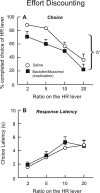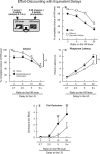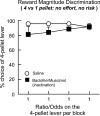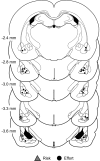Fundamental contribution by the basolateral amygdala to different forms of decision making
- PMID: 19386921
- PMCID: PMC6665478
- DOI: 10.1523/JNEUROSCI.0315-09.2009
Fundamental contribution by the basolateral amygdala to different forms of decision making
Abstract
Impairments in decision making about risks and rewards have been observed in patients with amygdala damage. Similarly, lesions of the basolateral amygdala (BLA) in rodents disrupts cost/benefit decision making, reducing preference for larger rewards obtainable after a delay or considerable physical effort. We assessed the effects of inactivation of the BLA on risk- and effort-based decision making, using discounting tasks conducted in an operant chamber. Separate groups of rats were trained on either a risk- or effort-discounting task, consisting of four blocks of 10 free-choice trials. Selection of one lever always delivered a smaller reward (one or two pellets), whereas responding on the other delivered a larger, four pellet reward. For risk discounting, the probability of receiving the larger reward decreased across trial blocks (100-12.5%), whereas on the effort task, the larger reward was delivered after a ratio of presses that increased across blocks (2-20). Infusions of GABA agonists baclofen/muscimol into the BLA disrupted risk discounting, inducing a risk-averse pattern of choice, and increased response latencies and trial omissions, most prominently during trial blocks that provided the greatest uncertainty about the most beneficial course of action. Similar inactivations also increased effort discounting, reducing the preference for larger yet more costly rewards, even when the relative delays to reward delivery were equalized across response options. These findings point to a fundamental role for the BLA in different forms of cost/benefit decision making, facilitating an organism's ability to overcome a variety of costs (work, uncertainty, delays) to promote actions that may yield larger rewards.
Figures






References
-
- Ahn S, Phillips AG. Independent modulation of basal and feeding-evoked dopamine efflux in the nucleus accumbens and medial prefrontal cortex by the central and basolateral amygdalar nuclei in the rat. Neuroscience. 2003;116:295–305. - PubMed
-
- Balleine BW, Killcross S. Parallel incentive processing: an integrated view of amygdala function. Trends Neurosci. 2006;29:272–279. - PubMed
-
- Baxter MG, Murray EA. The amygdala and reward. Nat Rev Neurosci. 2002;3:563–573. - PubMed
Publication types
MeSH terms
LinkOut - more resources
Full Text Sources
